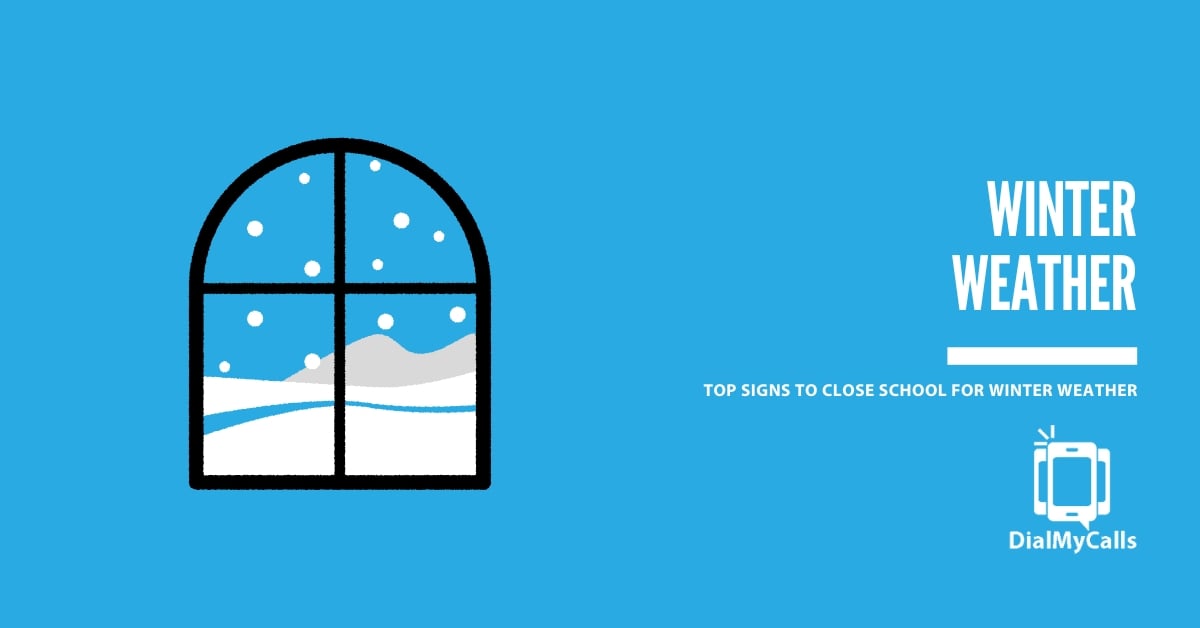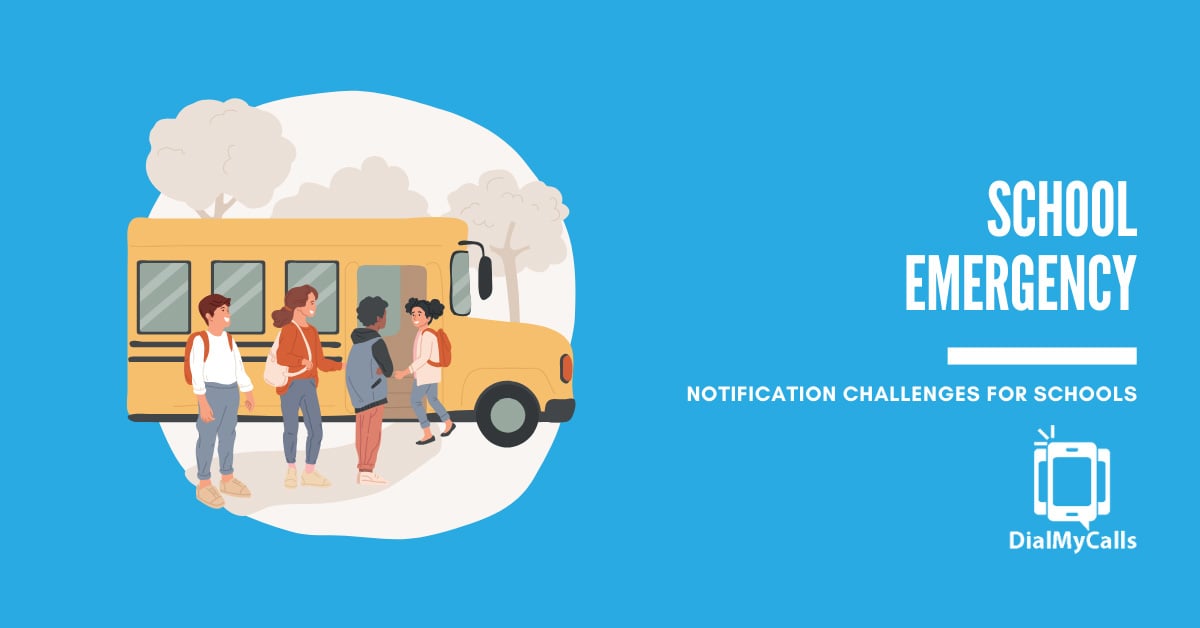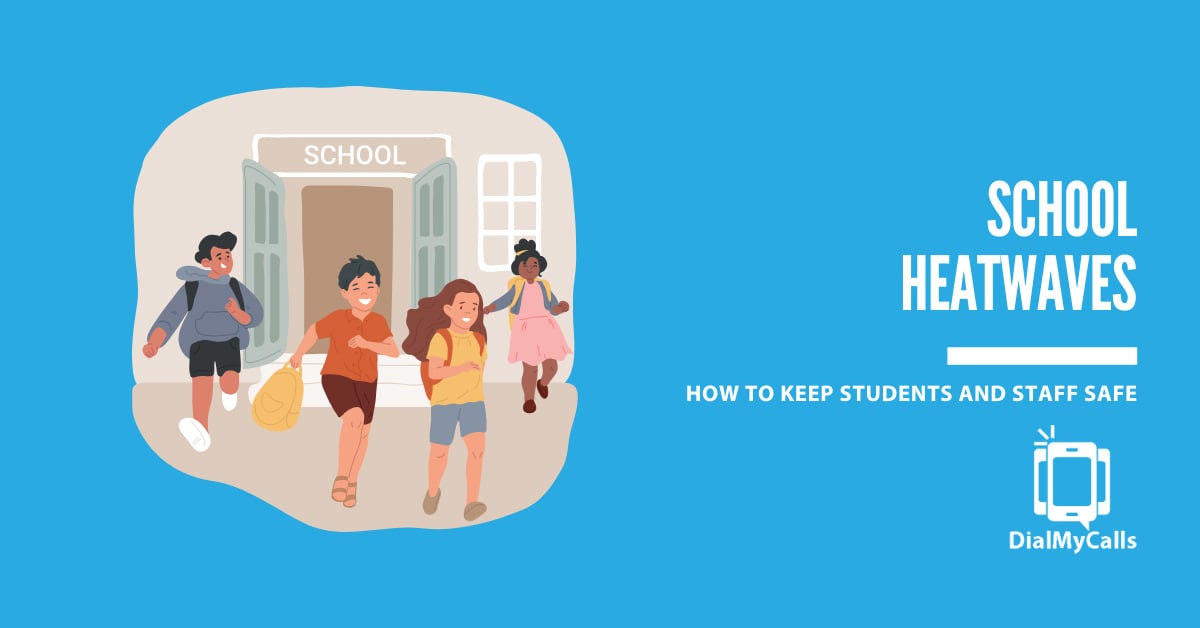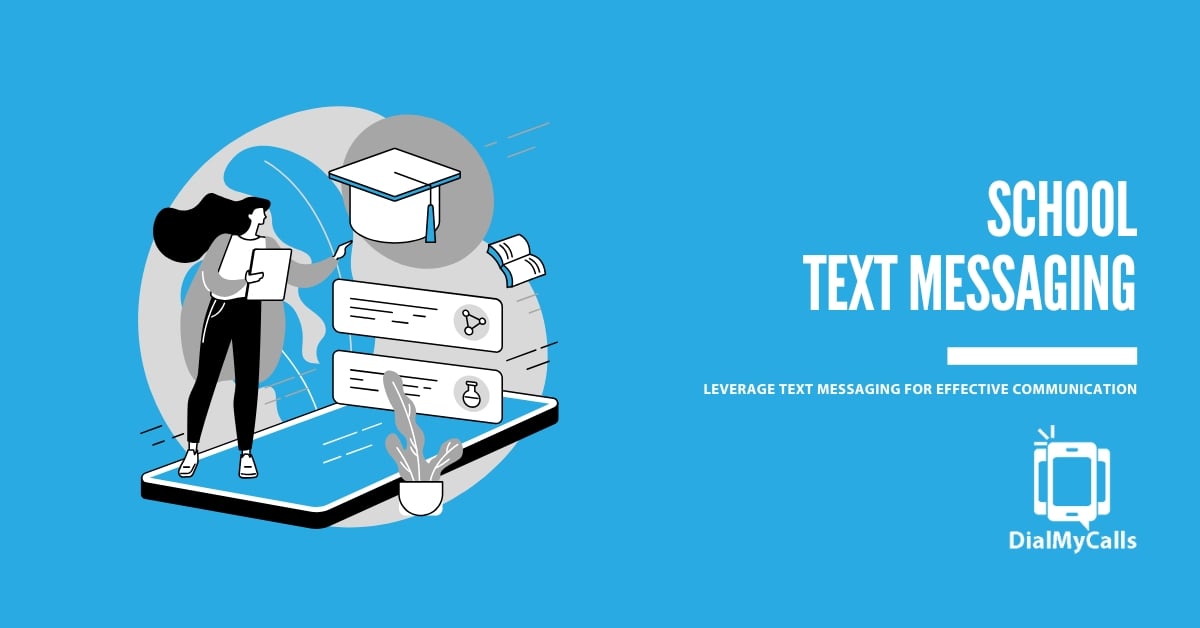Top 6 Signs It’s Time to Cancel School Due to Winter Weather

“Winter is coming” is not just a famous dialogue from a world-renowned series; it is also a plight for when the icy winds, blizzards, and ankle-deep snowfall wreak havoc on daily life. In such situations, the decision to keep schools open puts the safety of children and faculty at risk.
For administrators and parents, knowing when it’s time to hit the brakes on in-person learning is crucial to protect students, teachers, and staff. But what are the telltale signs of that? Now that’s the question.
In this blog, I will share the top 6 signs indicating it’s time to cancel school and how to keep everyone updated on the same.
Understanding Winter Weather Risks for Schools
As beautiful as the campus looks during winter months, the weather brings a variety of risks that impact not only the safety of transportation but also the overall school environment. When snow, ice, and freezing temperatures come into play, school administrators have to consider a range of factors to make the safest decisions for students, staff, and families. These factors include:
- Hazardous Roads: Forget walking, ice and snow-covered roads make driving buses and cars dangerous. No matter how much plowing and salting you do, treacherous conditions will most definitely persist. This is especially true in rural or less-serviced areas.
- Health Hazards from Extreme Cold: Frostbite and hypothermia are real concerns when temperatures drop severely. Students waiting for buses, walking, or lacking proper winter clothing face the highest risks.
- Power Outages: Sometimes, blizzards and heavy snow can knock out power, leaving classrooms without heat, lights, or essential equipment. This not only creates discomfort but also compromises the safety of everyone inside the building. Power outages also have severe effects on security systems, which are just as essential as the heating.
- Building Conditions: If the school is particularly old or has not been maintained properly, extreme winter temperatures can seriously test the structural integrity of the building as well as the older heating systems. If these systems fail to keep the heat intact inside the school, you have a serious problem at hand.
Stay Connected with Mass Notifications
Create & Send a Broadcast to Thousands in Seconds
Top 6 Signs to Consider for School Cancellations
- Freezing Rain and Ice Accumulation on Roads
- Extreme Low Temperatures and Dangerous Wind Chills
- Power Outages or Poor Heating Conditions at the School
- Hazardous Wind Conditions
- Staff and Transportation Availability
- Significant Snow Accumulation Overnight
Freezing Rain and Ice Accumulation on Roads
Snow can be tricky to navigate, but ice is an entirely different beast. Freezing rain and ice accumulation are top indicators that it’s unsafe to have school in session. Unlike snow, which can often be cleared by plowing and salting, ice leaves roads treacherous for vehicles and pedestrians alike. Freezing rain can coat roads, sidewalks, and driveways with a slick layer of ice, which is difficult for buses and parents to safely drive on, even with extra precautions.
Here are some more reasons that I consider ice to be super dangerous:
- Roads become nearly impossible to drive on safely.
- Ice on walkways increases the likelihood of slips and falls for students.
- Even salting or sanding can take hours to make a noticeable difference, and if the freezing rain continues, it often becomes an ongoing issue.
In such cases, canceling or delaying school gives road crews the time they need to treat surfaces, making transportation safer for everyone.
Extreme Low Temperatures and Dangerous Wind Chills
Frigid temperatures are part of winter in many regions, but extreme cold coupled with harsh wind chills can be harmful and even life-threatening. In areas where temperatures drop below freezing routinely, schools may operate as usual. However, when the temperature and wind chill dip into dangerous territory, exposing students and staff to the cold can pose serious health risks, including frostbite and hypothermia.
When to Cancel for Cold:
- The “feels like” temperature (accounting for wind chill) is below -20°F (-29°C) for more than a few hours.
- Waiting at the bus stop could expose students to frostbite risks in less than 10 minutes.
- School buildings may struggle to maintain a safe indoor temperature in extreme cold, especially if heating systems are older or malfunctioning.
Young children and students without adequate winter clothing are particularly vulnerable. So, if conditions reach these extreme lows, it’s best to cancel school to avoid the risk of exposure to dangerously cold temperatures.
Power Outages or Poor Heating Conditions at the School
Winter weather isn’t just about transportation hazards—sometimes, conditions at the school itself can make it impossible to have a normal day of learning. Heavy snowfall, freezing rain, and high winds often lead to power outages, which disrupt heating systems and lighting, leaving schools without the resources needed to maintain a safe and productive environment. Additionally, heating systems may falter under extreme cold or strain from consistent use, leaving classrooms too cold to function as effective learning environments.
Why Heating and Power Are Essential:
- Without power, schools can’t provide adequate lighting, heat, or technology-based instruction.
- A cold environment in classrooms can affect concentration and, in extreme cases, students’ health.
- Power outages may also disable school security systems and emergency communication systems, making it harder to ensure a safe space.
For schools in regions where winter power outages are more common, regular assessments of heating systems can help identify and address vulnerabilities. Still, if an outage or poor heating condition is expected to last for several hours or even days, canceling school is the most responsible decision.
Hazardous Wind Conditions
High winds can create serious hazards around schools, often in ways that go beyond what we see on the surface. Strong gusts can bring down trees, branches, and power lines, which may obstruct roads, damage school property, or even harm anyone nearby. In winter, this risk is heightened as trees weakened by ice or snow are more likely to snap, while icy power lines are vulnerable to snapping under pressure.
Falling trees and power lines can lead to power outages, disrupting heating and lighting inside the school, and potentially limiting communication systems and security. Additionally, high winds can make outdoor areas—like playgrounds, bus stops, and parking lots—unsafe for students and staff.
Tips for Managing Wind Hazards:
- Track Wind Advisories: Administrators can monitor local weather channels and government-issued advisories for updates on wind speeds, gust levels, and overall conditions.
- Consult Local Weather Services: Partnering with local meteorologists and weather services provides real-time insights and helps schools stay ahead of potentially hazardous winds.
By keeping a close watch on wind conditions, schools can proactively decide to cancel or delay classes when wind hazards make the surrounding areas unsafe.
Staff and Transportation Availability
One of the clearest signs that it may be time to cancel school during winter weather is limited availability of school staff and transportation personnel. Of course, I don’t need to tell you just how important these individuals are in keeping school operations safe and running smoothly.
How Shortages Impact Safety
- Limited Supervision: With fewer teachers or staff members available, student supervision may suffer, increasing the risk of accidents or emergencies going unnoticed.
- Transportation Delays: A shortage of bus drivers means longer wait times in cold temperatures and potentially crowded buses, which can create additional safety concerns.
- Increased Pressure on Remaining Staff: Those who do make it to work face higher demands, which can lead to fatigue, mistakes, or oversights in safety protocols.
By considering the availability of staff and transportation personnel, schools can make more informed decisions on whether to stay open. When staffing or transportation limitations pose significant risks, canceling school for the day is often the safest choice.
Significant Snow Accumulation Overnight
A thick blanket of snow in the morning often leads to the most urgent “Should we cancel school?” discussions. While many schools and municipalities are prepared to clear roads and sidewalks, heavy snow overnight can leave even the best-prepared areas struggling to stay ahead.
When Snow Accumulation Becomes a Problem:
- When snowfall reaches or exceeds six inches overnight, snow plows may not have time to clear all roads by morning.
- Sidewalks, bus stops, and school parking lots may still be buried, making it unsafe for students to navigate.
- Heavy snow impacts not only driving conditions but also pedestrian safety for students walking to school.
Significant snow accumulation can also create issues around the school campus itself, making parking lots and walkways difficult to traverse safely. Waiting until the snow is fully cleared or rescheduling to a later time allows local services to make streets and sidewalks more navigable.
Communication Strategies for School Cancellations
Closing schools is one thing but how do you keep everyone informed without indulging in calling every individual parent? Well, that’s where mass texting and mass notification systems come into play.
Here’s how you can utilize these exceptional services to inform everyone about school cancellations:
Having a dependable communication system to reach parents, students, and staff immediately is critical during winter weather. Mass notification tools, like DialMyCalls, allow schools to send automated alerts through text messages. These systems ensure that important updates reach everyone simultaneously, reducing the risk of mixed messages or delays.
Why Mass Notifications Work:
- Speed: Automated systems send alerts in seconds, making it easy to notify the entire school community right away.
- Consistency: With one message reaching everyone, there’s less room for misinterpretation or rumors.
Using mass notification tools also allows schools to track who has received and read messages, which can be useful in ensuring no one is left in the dark during urgent weather-related situations.
Tips for Clear Messaging Protocols
When announcing a school closure, clarity is key. To avoid confusion, schools should use short, straightforward language and keep details as specific as possible. This helps recipients understand what’s happening and what steps they may need to take, like arranging childcare or preparing for remote learning if needed. Here’s what I advise:
- Be Direct: Start with the essential information—state that school is canceled and for which day.
- Include Key Details: Mention any additional closures, such as after-school programs, and any alternate plans, like remote learning, if applicable.
- Specify Next Steps: If further updates are expected, provide instructions on where to find them or when to expect another alert.
Sample Text Message Templates for School Closure Announcements
Here are some sample text message templates to consider:
Basic School Closure Alert
Closure with Remote Learning Option
Delayed Start Notification
Closure with Expected Further Communication
Related Article:
Winter Weather Preparedness for Schools: Top 5 Safety Tips
Conclusion
In winter, school safety decisions are complex but essential. When snow and icy conditions arise, it’s crucial for schools to prioritize student, staff, and community well-being. By understanding weather risks, monitoring staff and transportation availability, and employing clear, effective communication, schools can navigate closures smoothly.
So, this winter, utilize mass notification tools like DialMyCalls to make it easy to keep everyone informed instantly. As each winter storm is unique, these proactive measures help ensure that every closure decision is made confidently, with safety as the top priority.
Keep Everyone Connected & Informed
Get the Word Out Quickly with Bulk Texting and Voice Calls
Author
Tim Smith is the Media Manager at DialMyCalls, where he has leveraged his expertise in telecommunications, SaaS, SEO optimization, technical writing, and mass communication systems since 2011. Tim is a seasoned professional with over 12 years at DialMyCalls and 15+ years of online writing experience.
Try Using DialMyCalls Right Now
Start For Free
Recent Posts
- 6 Top Emergency Notification Challenges Schools Face and How to Solve Them
- 7 Best Practices for Tornado and Severe Storm Emergency Notifications
- 7 Best Practices for Church Emergency Notifications to Keep Congregations Safe
- How Transportation and Logistics Use Emergency Alerts to Keep Operations Moving
- The ROI of an Emergency Notification System and Why It Pays for Itself
Categories
“I am a youth minister and have spent hours in the past calling students individually to remind them of an upcoming event or to get out an urgent announcement. With DialMyCalls.com, I cut that time down to about 1 minute. I also love how I can see exactly who answered live and how long they listened so I know if they heard the whole message. DialMyCalls.com is the best website I have stumbled upon all year! Thanks!”
Central Baptist Church
Try Using DialMyCalls Right Now
Start For Free
Author
Tim Smith is the Media Manager at DialMyCalls, where he has leveraged his expertise in telecommunications, SaaS, SEO optimization, technical writing, and mass communication systems since 2011. Tim is a seasoned professional with over 12 years at DialMyCalls and 15+ years of online writing experience.
Try Using DialMyCalls Right Now
Start For Free
Recent Posts
- 6 Top Emergency Notification Challenges Schools Face and How to Solve Them
- 7 Best Practices for Tornado and Severe Storm Emergency Notifications
- 7 Best Practices for Church Emergency Notifications to Keep Congregations Safe
- How Transportation and Logistics Use Emergency Alerts to Keep Operations Moving
- The ROI of an Emergency Notification System and Why It Pays for Itself
Categories
“I am a youth minister and have spent hours in the past calling students individually to remind them of an upcoming event or to get out an urgent announcement. With DialMyCalls.com, I cut that time down to about 1 minute. I also love how I can see exactly who answered live and how long they listened so I know if they heard the whole message. DialMyCalls.com is the best website I have stumbled upon all year! Thanks!”
Central Baptist Church
Try Using DialMyCalls Right Now
Start For Free


